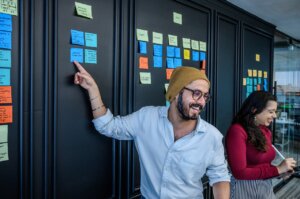Today mentors can and should provide expertise to protégés (males) or protégées (females)–essentially less experienced individuals to help them advance their careers, enhance their education, and build their networks. While mentoring is an important aspect to leadership training, it does not hold to a typical training environment or process; however, its tradition has existed even longer than traditional training.
Wikipedia always comes to the rescue when you need immediate clarification and not too much depth. It describes “mentoring” as a process that always involves communication and is relationship based, but its precise definition is elusive. There are two basic types of mentoring involving the training and development process that we are concerned with in this forum:
- the new-hire mentor. In this case, a more experienced person, not necessarily one of the people high up in the company heirarchy but high enough “sponsors” a new employee, giving them a polite tour of the corporate culture and then there is
- the high-potential mentorship. Usually, when we think of mentoring, we think of this kind–where especially selected employees are offered the opportunity to develop a relationship with a senior leader.

Both fit Wikipedia’s general definition: “Mentoring is a process for the informal transmission of knowledge, social capital, and the psychosocial support perceived by the recipient as relevant to work, career, or professional development; mentoring entails informal communication, usually face-to-face and during a sustained period of time, between a person who is perceived to have greater relevant knowledge, wisdom, or experience (the mentor) and a person who is perceived to have less (the protégé).”
Even so, can you train mentors and mentees to maximize the benefit and miss the formality imposed by training?
I think it’s possible, but there has to be some structure–points that focus and provide opportunities for mentees to learn important points of interpersonal and public communication, problem-solving/leadership techniques, company technical expertise and time management.
The only difference here and regular training is that the mentor is the trainer. Once the mentor is aware of the need for this focus, most leaders/senior management understand the need for training, and some would even welcome some structure to a system that is still sorting itself out.
Let’s face it: a mentor with a plan–that’s training. The new-hire mentor, as a mid-level employee, has nothing to lose and everything to gain if he treats his own mentee to real training, and guides him or her in the same way as the higher-level mentor; and his mentee would be a fool not to accept it. In the case of a high-potential mentorship, the bigger problem may actually be the trainee, the protégé or protégée–better known as the mentee who feels entitled to special treatment.

In this situation, we simply can’t train for the mentee position; someone has to be anointed–which, by the way, is not intended to be a negative sense. By virtue of being in that prime position, we may have someone who will only take direction from his or her mentor. That is why it is the mentor that must “do” the training.
To be one of the “anointed ones,” someone has to be noticed–having those qualities perceived by the the company or its leaders as “the right stuff” to be a leader of the future. That being said, it is important to note that Tom Wolfe’s novel, The Right Stuff, about the early space program is not about those men who do, in fact, have “the right stuff” defined by what is needed to fly a rocket into space, but rather what is perceived by the public as “the right stuff.” We know now that the Mercury astronauts were not selected for their ability to fly jets, but rather their reputation, and physical ability to take the rigors of space. Monkeys and dogs did sit in the same place and perform the same functions.
Unlike Wolfe’s message, which was not one of promise or fulfillment, the mentor program of today–just like the mentor program of days long past–still strive to select the very best and make it work. No one will argue the importance of such a program to the retention of key personnel and corporate knowledge.
A mentor will sometimes see himself or herself in an employee and decide this person with their guidance and wisdom can one day run the company. To make the mentoring process work, there has to be a deliberate effort to mold and shape an individual. Shadowing alone is not enough. Training mentors to train their mentees may be one way. Mentors who take the job seriously stand to do great things for a company’s future and much for their own legacy.
Mentoring in Europe has existed since at least Ancient Greek times. It’s really only since the 1970s that mentorism has spread in the United States, mainly in leadership training contexts. It has been described as “an innovation in American management.” If done well, the mentoring process will indeed serve the individual by providing the necessary exposure to the reality, the best training an employee can have, i.e., the experiential training needed to do the job.
—
For more resources about training, see the Training library.
For a look at the human side of training from my Cave Man perspective, please check out my book, The Cave Man Guide to Training and Development. Happy training.
 Sections of this topic
Sections of this topic















